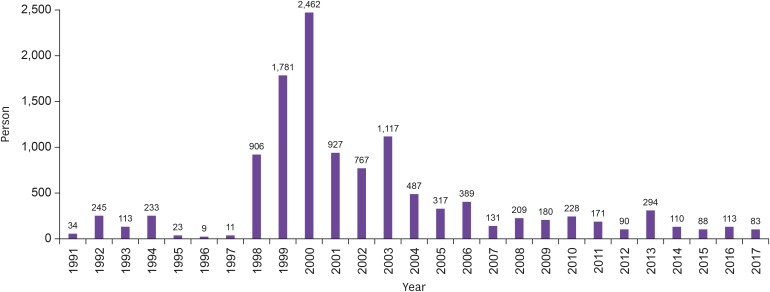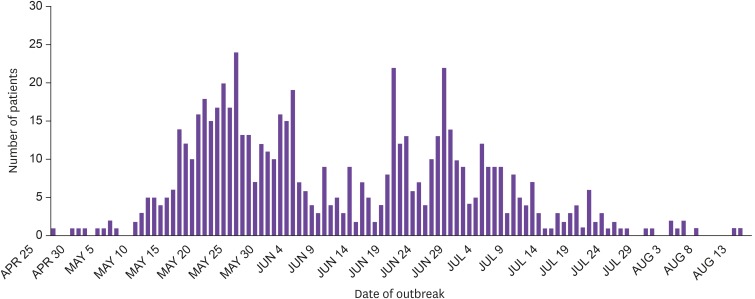Infect Chemother.
2020 Mar;52(1):123-131. 10.3947/ic.2020.52.1.123.
History and Epidemiology of Bacillary Dysentery in Korea: from Korean War to 2017
- Affiliations
-
- 1Division of Infectious Diseases, Department of Internal Medicine, College of Medicine, Hanyang University, Seoul, Korea
- KMID: 2507335
- DOI: http://doi.org/10.3947/ic.2020.52.1.123
Abstract
- Dysentery has been a major illness for a long time in our country. During Korean war, bacillary dysentery was common illness as well as other infectious diseases such as typhus fever, and Shigella flexneri occupied more than 90% of the cases reported by UN forces. After the war, the Korean National Institute of Health began to monitor the disease as a legal communicable disease. The incidence of dysentery decreased gradually from 1960 through 1980s and consistently low until 1997, and common serotype has changed from S. flexneri to S. sonnei. However, a nationwide epidemic of dysentery occurred at 1998, peaking at 2,462 cases in 2000, and continued until 2004. Most cases were S. sonnei, but the proportion of S. flexneri existed changing with time. There were several major epidemic cases during the period, and the dysentery outbreaks in 1998 and 1999 were associated with nationwide school meal provision which began in 1998. According to the region, Juju island particularly showed a high incidence rate in the period. Since 2005, the nationwide dysentery epidemic was over and incidence of dysentery remained stably low. Recently, multi-drug resistant Shigella infection imported from Southeast Asia appeared, and it requires continuous monitoring and control.
Figure
Reference
-
1. Chun CH. Acute infectious disease overview. Seoul: Latest Medical History;1975.2. Jwadeung. Dysentery (jeoklee) of Chosun dynasty. Guneuidan Magazine;1913.3. Zimmerman LE, Cooper M, Graber CD. Bacteriologic studies in an epidemic of bacillary dysentery in Korea; serotypes of Shigella and Salmonella recovered and bacteriologic response to sulfadiazine, chloramphenicol, terramycin, aureomycin and streptomycin. Am J Clin Pathol. 1952; 22:549–557. PMID: 14933330.4. Zimmerman LE. Some experiences with enteric diseases in Korea. Am J Public Health. 1953; 43:279–284.
Article5. Park S, Cho E. National infectious diseases surveillance data of South Korea. Epidemiol Health. 2014; 36:e2014030. PMID: 25420951.
Article6. Korea Centers for Disease Control and Prevention (KCDC). Infectious diseases portal. Available at: http://www.cdc.go.kr/npt/biz/npp/ist/simple/simplePdStatsMain.do#.7. Lee JC, Jeong YS, Oh JY, Kang HY, Kim KH, Kim J, Lee YC, Cho DT, Seol SY. Epidemiology of shigellosis in Korea. J Bacteriol Virol. 2006; 36:41–49.
Article8. Chun D. A review of Salmonella and Shigella in Korea. Endemic Dis Bull Nagasaki Univ. 1964; 6:125–138.9. Chun D, Kim C, Ahn D, Lee J. Studies on Salmonella and Shigella isolated in Taegu area in Korea. Korean Choong Ang Med J. 1964; 5:249–254.10. Chun D. Classification of dysentery bacilli and their prevalence in Korea. J Korean Med Assoc. 1970; 13:704–710.11. Ahn D, Chun D. Studies on Shigella isolated in Taegu area in Korea. Korean Choong Ang Med J. 1962; 3:265–270.12. Seol SY. Chunging patterns of serotypes and drug resistance of Salmonella and Shigella . Kyungpook Med J. 1980; 21:245–249.13. Kim KS, Oh JY, Jeong YW, Cho JW, Park JC, Cho DT, Lee JC. Epidemiological typing and characterization of dfr genes of Shigella sonnei isolates in Korea during the last two decades. J Microbiol Biotechnol. 2002; 12:106–113.14. Oh JY, Yu HS, Kim SK, Seol SY, Cho DT, Lee JC. Changes in patterns of antimicrobial susceptibility and integron carriage among Shigella sonnei isolates from southwestern Korea during epidemic periods. J Clin Microbiol. 2003; 41:421–423. PMID: 12517883.15. Lee JC, Oh JY, Kim KS, Jeong YW, Cho JW, Park JC, Seol SY, Cho DT. Antimicrobial resistance of Shigella sonnei in Korea during the last decades. APMIS. 2001; 109:228–234. PMID: 11430501.16. Chun BC. Epidemiological characteristics and effective management of re-emerging Shiegellosis. Ministry of Health and Welfare;2001.17. Pai H. Bacillary dysentery. J Korean Med Assoc. 2003; 46:527–532.
Article18. Central epidemiological survey team. Jeju Island epidemiological survey team. Report by central epidemiological survey team on the Jeju Island bacillary dysentery group outbreak. 2000.19. Lee HJ. Korea Centers for Disease Control and Prevention R&D projects research outcomes: Preparation of optimum control measures for the group outbreak of ESBL-producing shigella 2005. Available at: http://www.nih.go.kr/board.es?mid=a40801000000&bid=0050&act=view&list_no=1140.20. Kim HJ, Youn SK, Lee S, Choi YH. Epidemiological characteristics of imported shigellosis in Korea, 2010-2011. Osong Public Health Res Perspect. 2013; 4:159–165. PMID: 24159548.
Article21. Lee W, Chung HS, Lee H, Yum JH, Yong D, Jeong SH, Lee K, Chong Y. CTX-M-55-type extended-spectrum β-lactamase-producing Shigella sonnei isolated from a Korean patient who had travelled to China. Ann Lab Med. 2013; 33:141–144. PMID: 23483349.22. Kim JS, Kim JJ, Kim SJ, Jeon SE, Seo KY, Choi JK, Kim NO, Hong S, Chung GT, Yoo CK, Kim YT, Cheun HI, Bae GR, Yeo YH, Ha GJ, Choi MS, Kang SJ, Kim J. Outbreak of ciprofloxacin-resistant Shigella sonnei associated with travel to Vietnam, Republic of Korea. Emerg Infect Dis. 2015; 21:1247–1250. PMID: 26079171.23. Jeon YL, Nam YS, Lim G, Cho SY, Kim YT, Jang JH, Kim J, Park M, Lee HJ. Quinolone-resistant Shigella flexneri isolated in a patient who travelled to India. Ann Lab Med. 2012; 32:366–369. PMID: 22950074.24. DuPont HL. Shigella species (Bacillary dysentery). In : Mandell GL, Bennett JE, Dolin R, editors. Principles and practice of infectious diseases. 4th ed. New York: Churchill Livingstone;1995. p. 2033–2039.25. The Korean Society of Infectious Diseases Korean Society for Chemotherapy and The Korean Society of Clinical Microbiology. Clinical Guideline for the Diagnosis and Treatment of Gastrointestinal Infections. Infect Chemother. 2010; 42:323–361.26. Korea Center for Disease Control and Prevention. The outbreak of ESBL producing Shigella sonnei . Communicable Diseases Monthly Report. 2005; 16:1–5.27. Korea Centers for Disease Control and Prevention. National antimicrobial resistance monitoring status. Communicable Diseases Monthly Report. 2003; 14:273–282.28. Chun BC. Public policy and laws on infectious disease control in Korea: past, present and prospective. Infect Chemother. 2011; 43:474–484.
Article29. Korea Centers for Disease Control and Prevention (KCDC). Case definitions for national notifiable infectious diseases, 2011. KCDC;2010.



